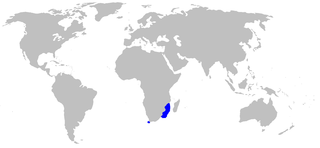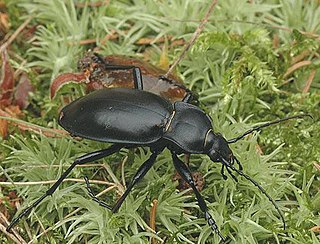
Tuatara are reptiles endemic to New Zealand. Although resembling most lizards, they are part of a distinct lineage, the order Rhynchocephalia. Their name derives from the Māori language, and means "peaks on the back". The single species of tuatara is the sole surviving member of its order, which originated in the Triassic period around 250 million years ago and which flourished during the Mesozoic era. Their most recent common ancestor with any other extant group is with the squamates. For this reason, tuatara are of interest in the study of the evolution of lizards and snakes, and for the reconstruction of the appearance and habits of the earliest diapsids, a group of amniote tetrapods that also includes dinosaurs and crocodilians.

The channel catfish is North America's most numerous catfish species. It is the official fish of Kansas, Missouri, Iowa, Nebraska, and Tennessee, and is informally referred to as a "channel cat". In the United States, they are the most fished catfish species with around 8 million anglers targeting them per year. The popularity of channel catfish for food has contributed to the rapid expansion of aquaculture of this species in the United States. It has also been widely introduced in Europe, Asia and South America, and it is legally considered an invasive species in many countries.

Diadophis punctatus, commonly known as the ring-necked snake or ringneck snake, is a harmless species of colubrid snake found throughout much of the United States, central Mexico, and southeastern Canada. Ring-necked snakes are secretive, nocturnal snakes, so are rarely seen during the day time. They are best known for their unique defense posture of curling up their tails, exposing their bright red-orange posterior, ventral surface when threatened.

Carabus nemoralis is a ground beetle common in central and northern Europe, as well as Iceland and Canada. While native to Europe, it has been introduced to and is expanding its range throughout North America.

The white-spotted Izak or African spotted catshark is a catshark of the family Scyliorhinidae. It is found in the western Indian Ocean off the coasts of Natal, South Africa, southern Mozambique, Madagascar, Kenya, and Tanzania between latitudes 4° S and 37° S, at depths of between 220 and 440 m. It can grow up to 35 cm in length.

Carabus intricatus, the blue ground beetle, is a species of ground beetle found in Europe.

Carabus is a genus of beetles in family Carabidae. The genus is highly diverse with 91 subgenera and more than 1000 recognised species, thus is the largest genus in the subfamily Carabinae. The vast majority are native to the Palearctic, but 11 Nearctic species are also known. Carabus spp. are 12–50 mm (0.47–1.97 in) long, and most species are wingless and often very colourful. These are nocturnal, predatory beetles that feed on snails, earthworms, and caterpillars.

Carabus auronitens is a species of beetle in family Carabidae which was described by Johan Christian Fabricius in 1792.

Carabus smaragdinus is a species of beetle belonging to the family Carabidae.

Carabus violaceus, sometimes called the violet ground beetle, or the rain beetle is a nocturnal species of a beetle, from the family Carabidae.
In the 10th edition of Systema Naturae, Carl Linnaeus classified the arthropods, including insects, arachnids and crustaceans, among his class "Insecta". Insects with hardened wing covers were brought together under the name Coleoptera.
Hervé de Toulgoët was a French entomologist. He specialised in moths of the families Arctiidae and Zygaenidae. He also studied the beetle genus Carabus. He was written about by Paul Thiaucourt and Jocelyne Navatte.

Carabinae is a subfamily of beetles in the family Carabidae, containing the following genera:

Carabus blaptoides is a species of ground beetle in the family Carabidae that can be found in Japan and Russia. The species are black coloured, but could have either purple or green pronotum.
Carabus exiguus is a species of black-coloured ground beetle in the Carabinae subfamily that is endemic to China.

Carabus hummeli is a species of ground beetle in the subfamily Carabinae that can be found in Russia and the eastern Palearctic realm. The species are brown coloured with blue pronotum. They also can be found in such Asian countries as China, Mongolia, and North Korea.
Carabus marietti is a species of ground beetle in the Carabinae subfamily that can be found in Bulgaria, European part of Turkey, and Near East.
Carabus obsoletus is a species of black-coloured beetle from family Carabidae, found in Czech Republic, Hungary, Moldova, Romania, Slovakia, Ukraine.

Carabus piochardi is a species of ground beetle from family Carabidae. They are black coloured, and are very similar to Carabus punctatus.
Carabus albrechti is a species of either black or brown coloured ground beetle in the subfamily Carabinae that is endemic to Japan.












